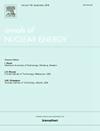Research on TOPSIS multi-indicator evaluation model based on entropy weight method for C2N site selection
IF 1.9
3区 工程技术
Q1 NUCLEAR SCIENCE & TECHNOLOGY
引用次数: 0
Abstract
The retrofitting of coal-fired power plants with coal-to-nuclear (C2N) technology emerges as a potent strategy for combating climate change and attaining objectives in energy transition. Technical feasibility and economical potential of C2N have been studied, however, how to select the best site from all potential candidates is still unknown. This paper introduces a TOPSIS-based multi-indicator evaluation model, employing the entropy weighting method, to explore the siting options for retrofitting Chinese coastal coal-fired power plants with nuclear technology. The findings reveal that the peak ground acceleration indicator carries the most weight, signifying its predominant influence on the evaluation scores. It is recommended that coal-fired power plants in specific southern provinces should be given priority in the implementation of the C2N strategy. The methodology and insights from this study serve as a vital reference for future research into siting challenges, facilitating the transition of coastal coal-fired power plants to cleaner and more efficient operations. This work contributes to the optimization of China’s energy mix and the advancement of sustainable development objectives.
基于熵权法的TOPSIS多指标评价模型在C2N选址中的研究
利用煤改核技术改造燃煤电厂已成为应对气候变化和实现能源转型目标的有力战略。研究了C2N的技术可行性和经济潜力,但如何从所有可能的候选地点中选择最佳地点仍然是未知的。本文引入基于topsis的多指标评价模型,运用熵权法探讨我国沿海燃煤电厂核电改造的选址选择。结果表明,峰值地面加速度指标的权重最大,表明其对评价分数的主要影响。建议在实施C2N战略时,优先考虑南方特定省份的燃煤电厂。本研究的方法和见解为未来研究选址挑战提供了重要参考,有助于沿海燃煤电厂向更清洁、更高效的运营过渡。这项工作有助于优化中国的能源结构,推进可持续发展目标。
本文章由计算机程序翻译,如有差异,请以英文原文为准。
求助全文
约1分钟内获得全文
求助全文
来源期刊

Annals of Nuclear Energy
工程技术-核科学技术
CiteScore
4.30
自引率
21.10%
发文量
632
审稿时长
7.3 months
期刊介绍:
Annals of Nuclear Energy provides an international medium for the communication of original research, ideas and developments in all areas of the field of nuclear energy science and technology. Its scope embraces nuclear fuel reserves, fuel cycles and cost, materials, processing, system and component technology (fission only), design and optimization, direct conversion of nuclear energy sources, environmental control, reactor physics, heat transfer and fluid dynamics, structural analysis, fuel management, future developments, nuclear fuel and safety, nuclear aerosol, neutron physics, computer technology (both software and hardware), risk assessment, radioactive waste disposal and reactor thermal hydraulics. Papers submitted to Annals need to demonstrate a clear link to nuclear power generation/nuclear engineering. Papers which deal with pure nuclear physics, pure health physics, imaging, or attenuation and shielding properties of concretes and various geological materials are not within the scope of the journal. Also, papers that deal with policy or economics are not within the scope of the journal.
 求助内容:
求助内容: 应助结果提醒方式:
应助结果提醒方式:


